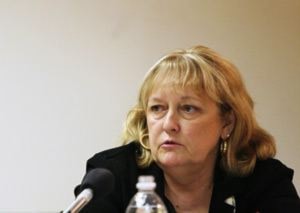A university in the territory is an idea whose time has come, agreed most of the 45 people who attended a public meeting in Whitehorse Tuesday.
“I love universities, and I love university towns,” said Gregory Heming, an educator from Haines Junction and columnist for The News, who chaired the meeting organized by the New Democratic Party caucus.
“It’s clear there’s a pressing need for northern citizens and citizens of the world” for a university in the Yukon, said Norm Easton, an instructor of archeology and northern studies at Yukon College.
The proposed Alaska Highway gas pipeline and a rail link from Alaska through the Yukon require a counterweight, otherwise we’re just back to the old boom-and-bust cycle, said Easton.
“A lot of what I’ve been hearing about economic development is really about community destruction,” he said, pointing out that welders working on a pipeline will have to move once the pipeline is finished, unless they have options to continue their education.
Two distinct roadmaps toward a university were provided at the meeting.
A community can push the government and private sector to invest in a university and then reap its economic windfall, said Deborah Poff, a founding member of the University of Northern British Columbia in Prince George.
“We’re a success story,” Poff said, comparing the UNBC experience to the Yukon’s situation.
In the late 1980s, Northern BC suffered from low participation rates in post-secondary education and a resource economy that was either booming or busting — much like the Yukon, she said.
To retain and recruit the best and brightest to Northern BC, 16,000 people from more than 250 communities signed a petition lobbying the government to investigate the feasibility of building a university in Prince George, she explained.
It worked: after $160 million in infrastructure spending, UNBC opened in 1994.
The “70-70 rule” shows the true potential of a university for a community, Poff said
“It has been found that 70 per cent of professionals — doctors, nurses, professors, engineers, scientists — stay within 70 kilometres of where they studied,” she said.
“If you want to build a university you have to think of the fit for your community,” she added. “We’re not McGill, we’re not Dalhousie.”
All of UNBC’s 25 undergraduate, 14 masters and two doctoral programs have co-op components.
The school’s 600 employees and 4,000 students add skills and cash to the community of Prince George, which is home to about 75,000 people, Poff said.
“The university has significantly added to the financial well-being of the community,” she said.
However, not everyone in the Yukon wants to follow UNBC’s particular route to success.
The gradual transition of Yukon College from quasi-university to a larger university-college that grants its own degrees is a better route to follow than UNBC’s, said Paul Driscoll, the dean of arts and sciences at Yukon College.
“My take on a Yukon university is that if Yukoners want a university, there will be a university,” Driscoll said.
The territory has a much smaller population base than Northern BC; that makes the recently opened University College of the North in The Pas, Manitoba, “a good fit for us to follow,” he said.
Thompson University in Kamloops, BC, which evolved from a community college to a university-college to a full university over 20 years, is another good model, he added.
Yukon College already hovers between college and university status, said Driscoll, in a subsequent interview Wednesday.
The college offers undergraduate degrees from the University of Regina and the University of the Arctic, and masters programs from the University of Alaska Southeast, in Juneau, and UNBC.
And it is batting above its weight as a community college, he said.
The school is the head in a Northern social economic project that includes heavy hitters like the University of Toronto.
“There’s about 12 major universities, and we’re the administrative lead. It isn’t typical for a college,” Driscoll said.
New facilities for research and a Cold Weather Innovation Cluster facility are being proposed and could make the Yukon a leader in the field, he added.
But First Nation citizens must consider whether a college or a university better serves their interests, argued Patricia Young, a non-First Nations student from the University of Alaska-Fairbanks who is in the Yukon doing archeological work.
Yukon College is currently “not living up to the potential that’s there” for First Nations participation, said Young, in an interview following the meeting.
